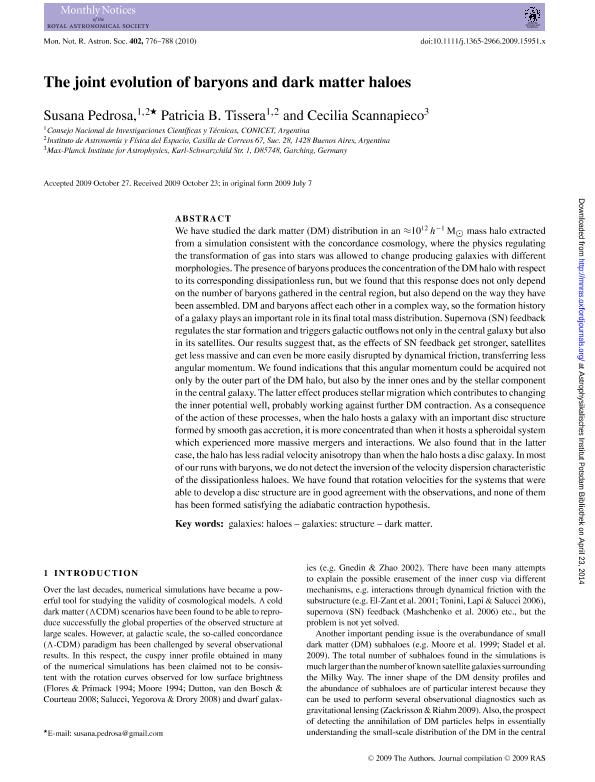Mostrar el registro sencillo del ítem
dc.contributor.author
Pedrosa, Susana Elizabeth

dc.contributor.author
Tissera, Patricia Beatriz

dc.contributor.author
Scannapieco, Cecilia

dc.date.available
2017-06-28T18:45:40Z
dc.date.issued
2010-02
dc.identifier.citation
Pedrosa, Susana Elizabeth; Tissera, Patricia Beatriz; Scannapieco, Cecilia; The joint evolution of baryons and dark matter haloes; Wiley Blackwell Publishing, Inc; Monthly Notices of the Royal Astronomical Society; 402; 2; 2-2010; 776-788
dc.identifier.issn
0035-8711
dc.identifier.uri
http://hdl.handle.net/11336/19032
dc.description.abstract
We have studied the dark matter (DM) distribution in an ≈1012 h−1 M mass halo extracted from a simulation consistent with the concordance cosmology, where the physics regulating the transformation of gas into stars was allowed to change producing galaxies with different morphologies. The presence of baryons produces the concentration of the DM halo with respect to its corresponding dissipationless run, but we found that this response does not only depend on the number of baryons gathered in the central region, but also depend on the way they have
been assembled. DM and baryons affect each other in a complex way, so the formation history of a galaxy plays an important role in its final total mass distribution. Supernova (SN) feedback regulates the star formation and triggers galactic outflows not only in the central galaxy but also in its satellites. Our results suggest that, as the effects of SN feedback get stronger, satellites get less massive and can even be more easily disrupted by dynamical friction, transferring less
angular momentum. We found indications that this angular momentum could be acquired not only by the outer part of the DM halo, but also by the inner ones and by the stellar component in the central galaxy. The latter effect produces stellar migration which contributes to changing the inner potential well, probably working against further DM contraction. As a consequence of the action of these processes, when the halo hosts a galaxy with an important disc structure formed by smooth gas accretion, it is more concentrated than when it hosts a spheroidal system which experienced more massive mergers and interactions. We also found that in the latter case, the halo has less radial velocity anisotropy than when the halo hosts a disc galaxy. In most of our runs with baryons, we do not detect the inversion of the velocity dispersion characteristic of the dissipationless haloes. We have found that rotation velocities for the systems that were able to develop a disc structure are in good agreement with the observations, and none of them has been formed satisfying the adiabatic contraction hypothesis.
dc.format
application/pdf
dc.language.iso
eng
dc.publisher
Wiley Blackwell Publishing, Inc

dc.rights
info:eu-repo/semantics/openAccess
dc.rights.uri
https://creativecommons.org/licenses/by-nc-sa/2.5/ar/
dc.subject
Galaxies:Haloes
dc.subject
Galaxies:Structure
dc.subject
Dark Matter
dc.subject.classification
Astronomía

dc.subject.classification
Ciencias Físicas

dc.subject.classification
CIENCIAS NATURALES Y EXACTAS

dc.title
The joint evolution of baryons and dark matter haloes
dc.type
info:eu-repo/semantics/article
dc.type
info:ar-repo/semantics/artículo
dc.type
info:eu-repo/semantics/publishedVersion
dc.date.updated
2017-06-26T19:49:09Z
dc.journal.volume
402
dc.journal.number
2
dc.journal.pagination
776-788
dc.journal.pais
Reino Unido

dc.journal.ciudad
Londres
dc.description.fil
Fil: Pedrosa, Susana Elizabeth. Consejo Nacional de Investigaciónes Científicas y Técnicas. Oficina de Coordinación Administrativa Ciudad Universitaria. Instituto de Astronomía y Física del Espacio. - Universidad de Buenos Aires. Facultad de Ciencias Exactas y Naturales. Instituto de Astronomía y Física del Espacio; Argentina
dc.description.fil
Fil: Tissera, Patricia Beatriz. Consejo Nacional de Investigaciónes Científicas y Técnicas. Oficina de Coordinación Administrativa Ciudad Universitaria. Instituto de Astronomía y Física del Espacio. - Universidad de Buenos Aires. Facultad de Ciencias Exactas y Naturales. Instituto de Astronomía y Física del Espacio; Argentina
dc.description.fil
Fil: Scannapieco, Cecilia. Consejo Nacional de Investigaciónes Científicas y Técnicas. Oficina de Coordinación Administrativa Ciudad Universitaria. Instituto de Astronomía y Física del Espacio. - Universidad de Buenos Aires. Facultad de Ciencias Exactas y Naturales. Instituto de Astronomía y Física del Espacio; Argentina. Max-Planck Institute for Astrophysics; Alemania
dc.journal.title
Monthly Notices of the Royal Astronomical Society

dc.relation.alternativeid
info:eu-repo/semantics/altIdentifier/url/http://mnras.oxfordjournals.org/content/402/2/776
dc.relation.alternativeid
info:eu-repo/semantics/altIdentifier/doi/http://dx.doi.org/10.1111/j.1365-2966.2009.15951.x
Archivos asociados
